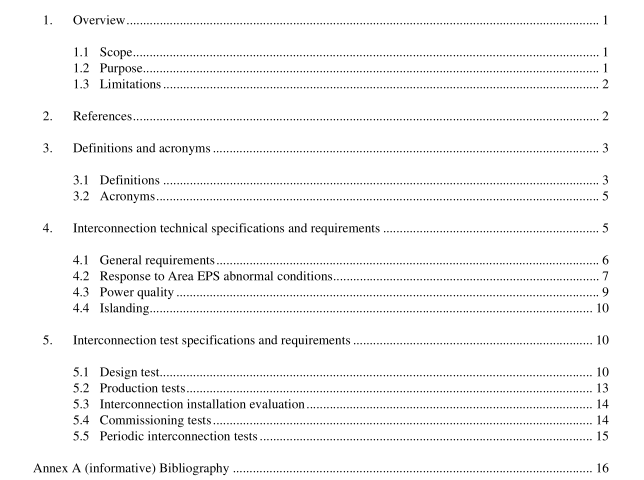IEEE 1547-2003 pdf download.IEEE Standard for Interconnecting Distributed Resources with Electric Power Systems
4. Interconnection technical specifications and requirements
The requirements in this clause shall be met at the PCC, although the devices used to meet these requirements can be located elsewhere. The requirements apply to interconnection of either a single DR unit based on that unit’s rating or multiple DR units within a single Local EPS, based on the aggregate rating of all the DR units that are within the Local EPS. The functions of the interconnection system hardware and software that affect the Area EPS are required to meet this standard regardless of their location on the EPS. The requirements in this clause are functional and do not specify any particular equipment or equipment type.
The stated technical specifications and requirements are universally needed for interconnection of DR, including synchronous machines, induction machines, or static power inverters/converters, and will be sufficient for most installations. 7
4.1 General requirements
4.1.1 Voltage regulation The DR shall not actively regulate the voltage at the PCC. The DR shall not cause the Area EPS service voltage at other Local EPSs to go outside the requirements of ANSI C84.1-1995, Range A.
4.1.2 Integration with Area EPS grounding The grounding scheme of the DR interconnection shall not cause overvoltages that exceed the rating of the equipment connected to the Area EPS and shall not disrupt the coordination of the ground fault protection on the Area EPS.
4.1.3 Synchronization The DR unit shall parallel with the Area EPS without causing a voltage fluctuation at the PCC greater than ±5% of the prevailing voltage level of the Area EPS at the PCC, and meet the flicker requirements of 4.3.2.
4.1.4 Distributed resources on distribution secondary grid and spot networks
4.1.4.1 Distribution secondary grid networks This topic is under consideration for future revisions of this standard.
4.1.4.2 Distribution secondary spot networks
Network protectors shall not be used to separate, switch, serve as breaker failure backup or in any manner isolate a network or network primary feeder to which DR is connected from the remainder of the Area EPS, unless the protectors are rated and tested per applicable standards for such an application. 9 Any DR installation connected to a spot network shall not cause operation or prevent reclosing of any network protectors installed on the spot network.
This coordination shall be accomplished without requiring any changes to prevailing network protector clearing time practices of the Area EPS. Connection of the DR to the Area EPS is only permitted if the Area EPS network bus is already energized by more than 50% of the installed network protectors.
The DR output shall not cause any cycling of network protectors. The network equipment loading and fault interrupting capacity shall not be exceeded with the addition of DR.
DR installations on a spot network, using an automatic transfer scheme in which load is transferred between the DR and the EPS in a momentary make-before-break operation, shall meet all the requirements of this clause regardless of the duration of paralleling.
4.1.5 Inadvertent energization of the Area EPS The DR shall not energize the Area EPS when the Area EPS is de-energized.
4.1.6 Monitoring provisions Each DR unit of 250 kVA or more or DR aggregate of 250 kVA or more at a single PCC shall have provisions for monitoring its connection status, real power output, reactive power output, and voltage at the point of DR connection.
4.1.7 Isolation device When required by the Area EPS operating practices, a readily accessible, lockable, visible-break isolation device shall be located between the Area EPS and the DR unit.
4.1.8 Interconnect integrity
4.1.8.1 Protection from electromagnetic interference The interconnection system shall have the capability to withstand electromagnetic interference (EMI) environments in accordance with IEEE Std C37.90.2-1995. The influence of EMI shall not result in a change in state or misoperation of the interconnection system. 4.1.8.2 Surge withstand performance The interconnection system shall have the capability to withstand voltage and current surges in accordance with the environments defined in IEEE Std C62.41.2-2002 or IEEE Std C37.90.1-2002 as applicable.
4.1.8.3 Paralleling device The interconnection system paralleling-device shall be capable of withstanding 220% of the interconnection system rated voltage.
4.2 Response to Area EPS abnormal conditions 10 Abnormal conditions can arise on the Area EPS that require a response from the connected DR. This response contributes to the safety of utility maintenance personnel and the general public, as well as the avoidance of damage to connected equipment, including the DR. All voltage and frequency parameters specified in these subclauses shall be met at the PCC, unless otherwise stated.
4.2.1 Area EPS faults The DR unit shall cease to energize the Area EPS for faults on the Area EPS circuit to which it is connected.IEEE 1547 pdf download.IEEE 1547-2003 pdf download
IEEE 1547-2003 pdf download

Leave a Reply